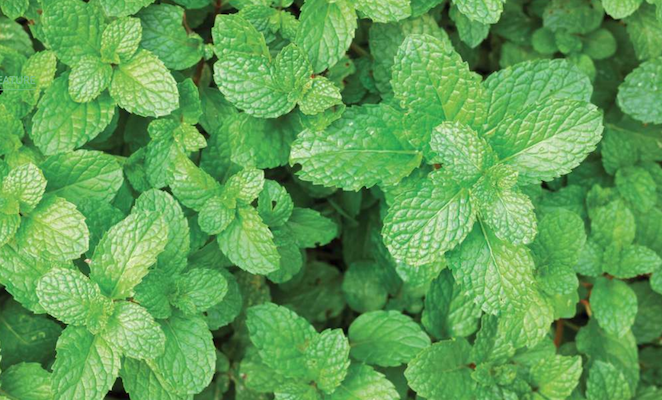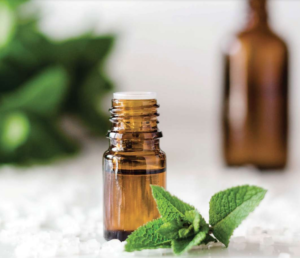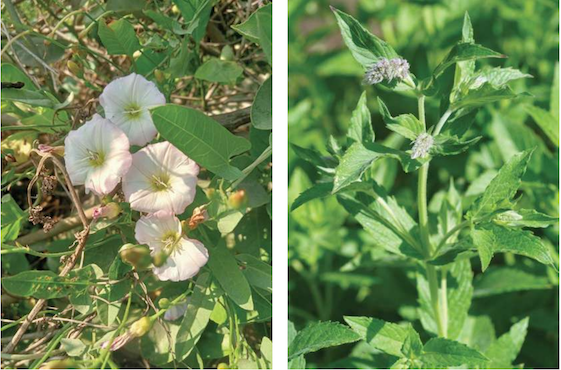The Unexplored Might of Mint January 9, 2022

Every toddler-parent faces it. It’s something that we all have done secretly at some point. It’s what we sometimes as adults do too – licking toothpaste off our brush and enjoying the sharp zesty freshness of the aftertaste. That signature toothpaste taste of course, as we all know, is due to the presence of menthol. More than 25 species belong to the genus Mentha in the plant family Lamiaceae, but the commonest mentha piperita, a favourite flavour in the food and fragrance industry is what the world knows by the common moniker of peppermint. Its active chemical terpene is the conventional menthol or peppermint camphor.
Kitchen garden or agricultural plantation, anyone who has grown mint is well-versed with its dominant personality. Its invasive nature makes it possessive of its terrain. The herb, though a popular flavouring agent, has not been able to ‘live and let live’ with common herbs such as lavender, rosemary, sage, and thyme.
Kitchen garden or agricultural plantation, anyone who has grown mint is wellversed with its dominant personality. Its invasive nature makes it possessive of its terrain. The herb, though a popular flavouring agent, has not been able to ‘live and let live’ with common herbs such as lavender, rosemary, sage, and thyme. Much to the chagrin of gardeners, it has the propensity to spread swiftly and choke out other neighbouring plants, and quite literally take over the garden. If not grown in a controlled manner or in a container, mint can defeat the best green fingers because, well, it doesn’t like to be contained. It is because of this weed-like quality that the plant is perpetually in the bad books of most farmers.
However, recent research has thrown up some startling discoveries that might win mint immense favour with farmers. Weeds are the bane of all horticulturists, botanists, cultivators, and farmers who spend a considerable amount of time on weed management. They compete for the same ecological cosmos. The world over, they are the most common cause of harvest loss, especially in the cultivation of crops such as wheat, rice, maize, potato, soybean, and cotton. Unabated and unchecked, weeds can damage up to 80 per cent of the agricultural yield. Chemical herbicides are neither sustainable nor safe. Another factor to consider is that the weeds, over a period of time and prolonged usage, develop resistance. With the growing clamour of food safety and awareness of healthy consumption, the chemical pesticide sector is under stress. In consideration of this, there is a global movement to discover effective yet safe, plant-based alternative pest and weed deterrents.
Experiments by Peter Nick, Professor of Molecular Cell Biology at the KIT Botanical Institute revealed that terpenes in menthol may be the cause of biological communication triggering self-regulated cell death in plants growing close to mint. Plants develop defence mechanisms to adapt and protect thems elves and release bio-chemicals through the process of allelopathy. Essential oils containing monoterpenes may sometimes accumulate in plant organs such as leaves, bark, wood, roots, flowers or even fruits. Often, large concentrations of essential oils are found in lysogenic or schizogenic oil ducts of the plant. These allelochemicals when released into the environment inhibit the growth of other plants growing nearby. In most instances, allelopathy biochemicals are volatile and are potent enough to inhibit the growth potential of other plants upon contact.
elves and release bio-chemicals through the process of allelopathy. Essential oils containing monoterpenes may sometimes accumulate in plant organs such as leaves, bark, wood, roots, flowers or even fruits. Often, large concentrations of essential oils are found in lysogenic or schizogenic oil ducts of the plant. These allelochemicals when released into the environment inhibit the growth of other plants growing nearby. In most instances, allelopathy biochemicals are volatile and are potent enough to inhibit the growth potential of other plants upon contact.
As part of the experiment, Professor Nick and his team extracted essential oils from a variety of mints grown at the KIT Botanical Institute. In each of these oils the individual bio-active compounds were meticulously marked with the help of molecular markers. Other herbs and shrubs, planted in close proximity, were put under keen scrutiny to observe the effect of the signals. Subsequently, cell cultures of the mint were also undertaken. The results showed that the presence of menthone in mint essential oil catalysed the self-destruction or cellular suicide of microtubules in nearby shrubs.
The KIT studies open new avenues in the unexplored might of mint as vital bio-herbicides while ensuring food safety and wellness.
Humankind’s battle with weeds is an age-old one. The most primitive method of weed control was physical uprooting of unwanted plants before the Romans ushered in the concept of chemical weed control. Now, as the world moves towards cleaner food systems, herbicides have gained prominence though there are several challenges of expense and weeds developing resistance. The KIT findings, recently published as a thesis, point towards the different mint oil allelochemicals being significantly effective control mechanisms against a variety of weeds. Common mint, it was observed, was highly effective in controlling weed marsh, a common menace in mountain pastures. In another instance, horse mint essential oil induced cellular suicide in the protein actin; therefore, an effective herbicide for field bindweed. On the other hand, reports indicated that mint allelopathic chemicals seemed to exhibit a growth-stimulating effect on crops such as apple. Another factor that contributes towards this weed-management property of mint is the fact that any herbicide must be in contact with the weed or be absorbed by the target plant in sufficient concentration. So, next time the plants surrounding your mint bed start to wither, don’t be puzzled. It’s the mint!

The use of herbicide is now a regular feature in agricultural planning and practice. Natural bio-herbicides score over chemical pesticides in more ways than one. Herbicides offer improved weed management and minimum crop loss, environmental as well as health benefits and above all, economy of cost. The KIT studies open new avenues in the unexplored might of mint as vital bio-herbicides while ensuring food safety and wellness.
Favoured far and wide and through the ages, Mentha has enjoyed a love-hate relationship with botanists and cultivators. Its medicinal and aroma-therapeutic properties are well-documented. Now, this darling of multiple indigenous cuisines around the world, the modest mint might just turn out the friend the industry needs and not the foe it is widely considered to be. Another reason to love this hard-to-hate, humble mint!
 Ultra International B.V.
Ultra International B.V.